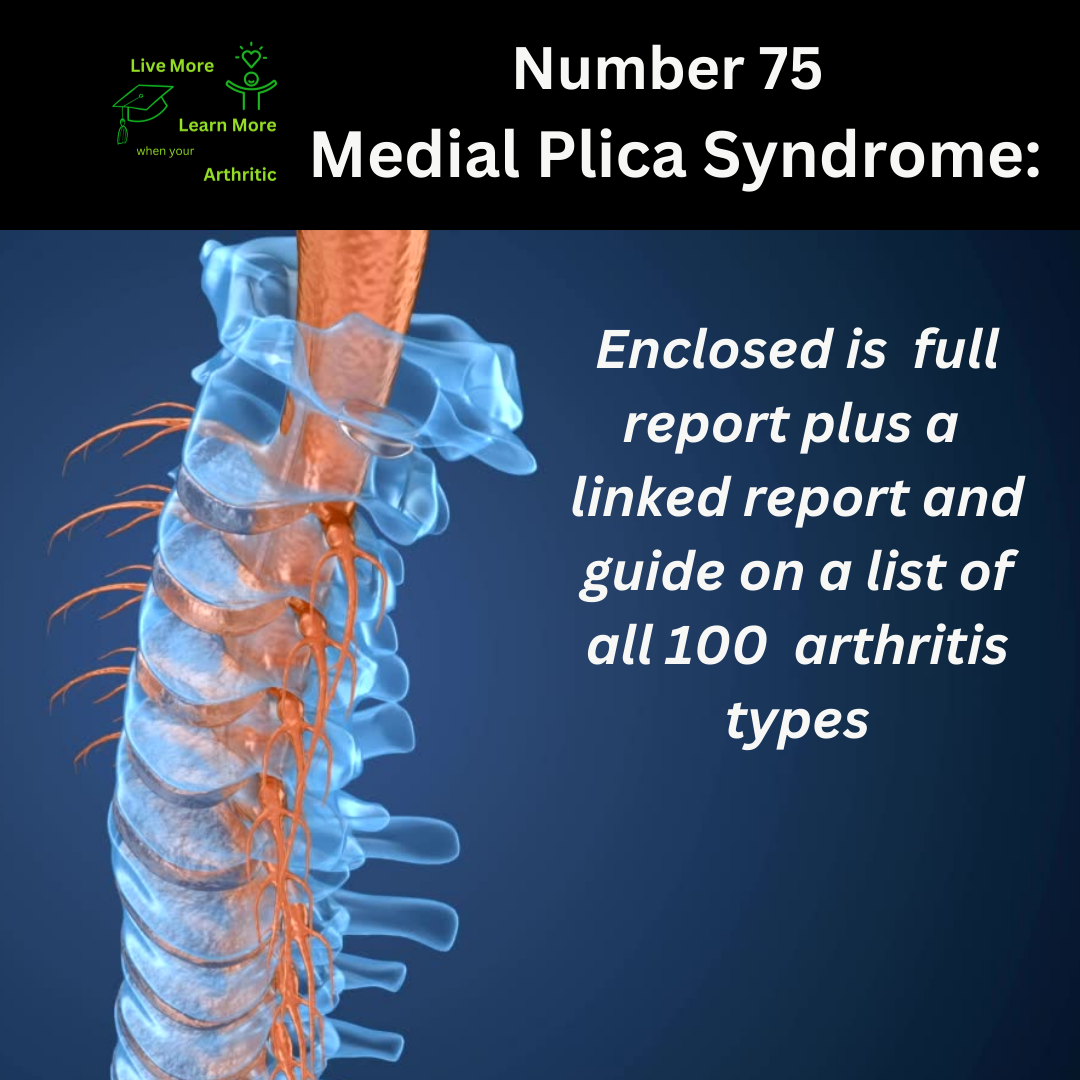
Medial Plica Syndrome: Number 75 on the list of 100 types of Arthritis
Medial plica syndrome is a condition that affects the knee joint, specifically involving irritation or inflammation of the medial plica, which is a fold of synovial tissue within the knee. This syndrome is characterized by knee pain and discomfort, particularly during activities that involve bending or twisting of the knee.
 Description of Medial Plica Syndrome
Description of Medial Plica Syndrome
The medial plica is a remnant of tissue from fetal development that usually diminishes as the knee matures. However, in some individuals, this tissue can persist and become inflamed, leading to symptoms of medial plica syndrome. The condition is often associated with repetitive knee movements or trauma.
Causes and Triggers
Medial plica syndrome can be caused by repetitive stress on the knee joint, such as activities involving running, jumping, or cycling. It can also result from direct trauma to the knee or improper biomechanics during physical activities. In some cases, underlying conditions like arthritis or previous knee injuries may contribute to the development of medial plica syndrome.
Symptoms and Limited Range of Motion
Common symptoms of medial plica syndrome include:
- Pain along the inside of the knee joint, especially with bending or straightening the knee
- Swelling or tenderness over the medial (inner) aspect of the knee
- Clicking or popping sensation with knee movement
- Difficulty fully straightening or bending the knee due to discomfort
The limited range of motion in medial plica syndrome is often due to pain and inflammation around the knee joint, which can affect the smooth movement of the knee cap (patella).
Onset and Demographics
Medial plica syndrome can occur at any age but is more common in younger individuals, particularly athletes or active individuals who engage in repetitive knee-loading activities. There is no significant gender predilection, as both men and women can be affected.
Lifespan Impact and Prognosis
Medial plica syndrome does not typically shorten one’s lifespan or have systemic effects like arthritis. With appropriate management and treatment, most individuals with this condition can experience significant improvement in symptoms and return to their normal activities.
Quality of Life and Proactive Approaches
Proactive approaches to managing medial plica syndrome involve:
- Rest and activity modification to avoid aggravating knee symptoms
- Physical therapy to strengthen the muscles around the knee and improve joint stability
- Proper biomechanical training to optimize movement patterns and reduce stress on the knee joint
- Use of supportive devices such as knee braces or taping techniques to provide additional stability during activities
Complications and Associated Conditions
Complications of medial plica syndrome are generally limited to persistent knee pain or functional limitations if not adequately managed. In some cases, individuals with this syndrome may develop secondary issues like patellofemoral pain syndrome or cartilage damage due to altered knee mechanics.
 Natural Breakthroughs and Health Advantages
Natural Breakthroughs and Health Advantages
While there are no specific natural breakthroughs associated with medial plica syndrome, maintaining a healthy lifestyle with regular exercise, weight management, and proper nutrition can support overall joint health and reduce the risk of knee injuries or related conditions.
Interconnected Diseases or Conditions
Medial plica syndrome is often associated with other knee conditions, such as patellofemoral pain syndrome, meniscal injuries, or ligamentous instability. Understanding these interconnected conditions is important for accurate diagnosis and effective treatment planning.
In summary, medial plica syndrome is a knee condition characterized by irritation of the medial plica, leading to pain and discomfort during knee movement. While it can impact daily activities, proactive management through rest, physical therapy, and biomechanical interventions can help individuals with this syndrome achieve a higher quality of life and return to their desired level of activity. Understanding the causes, symptoms, and treatment options for medial plica syndrome is essential for effective management and optimal recovery.

